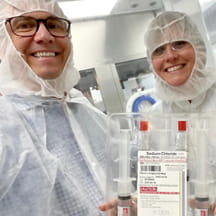Zei Uwadia made national headlines in 2018 when she walked the halls of Children's Mercy Kansas City while on life support. All told, she spent more than six months connected to an extracorporeal membrane oxygenation (ECMO) machine while battling a mysterious lung ailment. Zei eventually succumbed to the illness shortly after her 17th birthday, but her memory lives on for the doctors who cared for her.
"Being able to do all this work to honor her memory goes back to her story and the strength she exhibited while she was here," says Jenna Miller, M.D., FAAP, pediatric intensivist, Children's Mercy in Kansas City, Missouri. "It's an honor to carry that forward."
National media exposure leads to similar cases, fuels research effort
That work focuses on trimethoprim-sulfamethoxazole, more commonly known as Bactrim. It's a regularly prescribed antibiotic used to treat a variety of ailments, including urinary tract infections, acne and skin and soft tissue infections. While the cause of Zei's lung condition was unknown, Miller and the care team at Children's Mercy began to suspect Bactrim might be behind her mysterious illness.
The CNN report of Zei's extraordinary mobility while on life support prompted the parents of four similarly afflicted children to reach out—Bactrim was the common thread. Those five cases provide the foundation for the research Miller and her co-authors published last year, linking Bactrim to severe acute respiratory failure in otherwise healthy adolescents.
Since then, more parents and fellow health care professionals have reached out—and they've identified about two dozen more cases. Those patients will help inform the further research Miller and her team are now working on toward determining why this happens and what can be done to prevent it.
"That's our goal. Bactrim's a great drug, and we'd love to be able to use it for the 99% of patients who can tolerate it and have some kind of biomarker for the 1% who would be at high-risk for a reaction," says Jennifer Goldman, M.D., a pediatric infectious disease specialist at Children's Mercy. "We are doing further genetic evaluation in hopes of finding a potential marker that eventually could be used to identify patients before they develop a reaction."
"Not a war on Bactrim," but an educational campaign
In the meantime, Miller and Goldman hope word of this potentially fatal—albeit very rare—reaction to Bactrim among adolescents continues to spread.
"This is not a war on Bactrim, but it is highlighting potential adverse effects that have been overlooked or not observed in the past," Goldman says. "A lot of times the history of being on Bactrim didn't even come out initially in these patients who were critically ill."
There's not adequate data available to indicate precisely what percentage of adolescents are at risk for acute respiratory failure due to Bactrim use, according to Miller. But she says her goal is to educate providers about the possible risk in line with other adverse drug reactions. "Stevens-Johnson syndrome (a rare, serious disorder of the skin and mucous membranes that is usually a reaction to medication) is also rare, yet almost every medical provider knows about that reaction," Miller says. "What we're trying to do is elevate this reaction to the awareness level that Stevens-Johnson has."
One big step in that direction occurred last year when the U.S. Food and Drug Administration (FDA) added Bactrim to their watch list. "That was important because it added validation to our work," Miller says. "And we continue to work with the FDA on indications for using Bactrim because that would trickle down to providers—people may think differently about using it in certain scenarios."
Zei's memory continues to drive research
Many challenges lie ahead for Miller and Goldman in spreading the word to prevent future cases of this rare respiratory condition—data is scarce and medical records can be difficult to attain. But they do not lack inspiration to push forward.
"It's in Zei's memory that we're able to put these patients together and hopefully save future patients from having to go through this," Miller says. "I think that's the biggest push for us—it keeps us going because we know this is what she'd want us to do and she would be proud to be a part of this."


